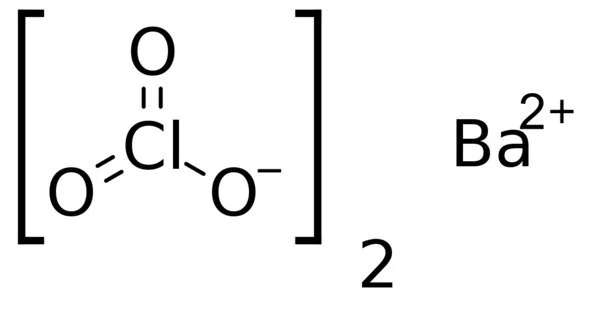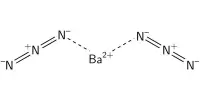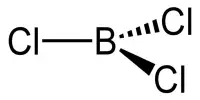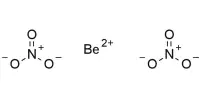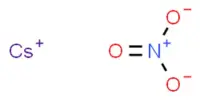The barium salt of chloric acid is barium chlorate, Ba(ClO3)2. It is a white crystalline solid that is irritant and toxic, as are all soluble barium compounds. It is occasionally used in pyrotechnics to create a green color. It is easily produced by electrolysis, but the current efficiency is lower than that of other chlorates. It is also used in the manufacture of chloric acid.
In pyrotechnics, barium chlorate is used to create a vivid green color. It is used in explosives and pyrotechnics, dyeing textiles, and the production of other chlorates.
Properties
Barium chlorate is a crystalline white solid. It combines with combustible materials to form highly flammable mixtures. If the combustible material is finely divided, it mixtures can be ignited by friction and can be explosive. Sulfuric acid solutions that have been concentrated may cause fires or explosions.
- Chemical formula: Ba(ClO3)2
- Molar mass: 304.23 g/mol
- Appearance: white solid
- Density: 3.18 g/cm3, solid
- Melting point: 413.9 °C (777.0 °F; 687.0 K) (decomposes)
- Solubility in water: 27.5 g/100 ml (20 °C)
- Magnetic susceptibility (χ): -87.5·10-6 cm3/mol
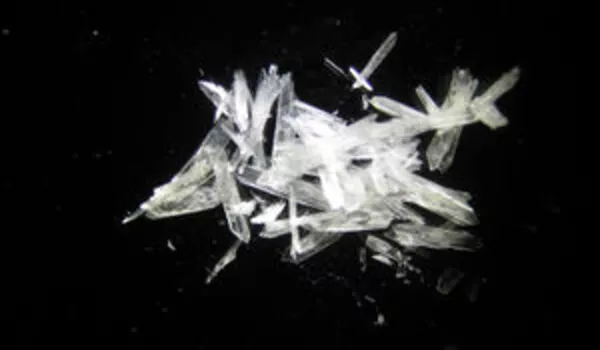
Synthesis
Barium chlorate can be produced through a double replacement reaction between solutions of barium chloride and sodium chlorate:
BaCl2 + 2 NaClO3 → Ba(ClO3)2 + 2 NaCl
When the resulting mixture is concentrated and chilled, barium chlorate precipitates. This is probably the most common preparation, taking advantage of barium chlorate’s lower solubility when compared to sodium chlorate.
The method described above does result in some sodium contamination, which is undesirable for pyrotechnic purposes because the strong yellow of sodium can easily overpower the green of barium. Electrolysis can be used to produce sodium-free barium chlorate:
BaCl2 + 6 H2O → Ba(ClO3)2 + 6 H2
It can also be produced by the reaction of barium carbonate with boiling ammonium chlorate solution:
2 NH4ClO3 + BaCO3 + Q → Ba(ClO3)2 + 2 NH3 + H2O + CO2
The reaction generates barium chlorate and ammonium carbonate initially; boiling the solution decomposes the ammonium carbonate and drives off the resulting ammonia and carbon dioxide, leaving only barium chlorate in solution.
Barium chlorate and barium nitrate produce the green in this firework.
Decomposition
When exposed to heat, barium chlorate alone will decompose to barium chloride and oxygen:
Ba(ClO3)2 → BaCl2 + 3 O2
Chloric acid
Barium chlorate is used to produce chloric acid, the formal precursor to all chlorate salts, through its reaction with dilute sulfuric acid, which results in a solution of chloric acid and insoluble barium sulfate precipitate:
Ba(ClO3)2 + H2SO4 → 2 HClO3 + BaSO4
Before mixing, both the chlorate and the acid should be prepared as dilute solutions so that the chloric acid produced is dilute, as concentrated chloric acid solutions (above 30%) are unstable and prone to decompose, sometimes explosively.
Commercial applications
When barium chlorate is burned with a fuel, it emits a bright green light. Because it is an oxidizer, a chlorine donor, and contains a metal, this compound produces an unrivaled green color. However, because all chlorates are unstable to sulfur, acids, and ammonium ions, they have been banned from use in class C fireworks in the United States. As a result, an increasing number of fireworks manufacturers have begun to use more stable compounds such as barium nitrate and barium carbonate.
Environmental Hazard
Barium chlorate is harmful to humans and the environment. If it is leached into bodies of water, it is extremely toxic to aquatic organisms. Although chemical spills of this compound are uncommon, they can harm entire ecosystems and should be avoided. This compound must be disposed of as hazardous waste. Barium chlorate is classified as hazardous by the Environmental Protection Agency (EPA).
